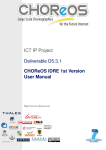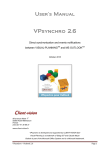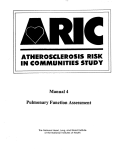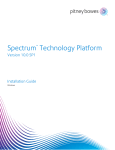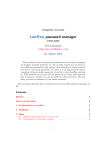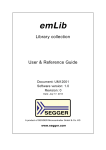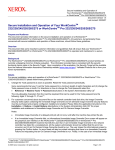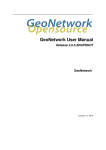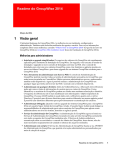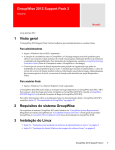Download Setup and administration manual LinShare
Transcript
LINAGORA
Setup and administration
manual
LinShare
LinShare 1.5.0
Version 1.5.0
April 24, 2014
Identifier : Linagora_DOC_LinShare1.5.0_Setup_Admin_Manual
Original file : Linagora_DOC_LinShare1.5.0_SetupAdminManual_en_20140429.odt
Groupe LINAGORA
80, rue Roque de Fillol
92800 PUTEAUX
FRANCE
SIRET : 431 473 669 00098
Tel.: +33 (0)1 46 96 63 63
Fax : +33 (0)1 46 96 63 64
http://www.linagora.com/
Diffusion : Public
Ref.: LinShare
Setup and administration manual
LinShare
Document evolution
Visa
NAME
DRAFTING
APPROVAL
VALIDATION
Camille TJHOA
Frédéric MARTIN
David CARELLA
Dev Java
Lead Dev LinShare
PKI Expert
FUNCTION
DATE
VISA
Version history
Addition of his name by any new actor contributor incurs his express and formal consent to
the diffusion of the present document pursuant to the licence on page 4.
VERSION
DATE
ACTOR
CONTRIBUTOR
0.1
31/01/2012
Camille TJHOA
0.2
02/02/2012
Frédéric MARTIN
Corrections.
0.3
20/02/2012
David CARELLA
Mise en forme, relecture et corrections.
1.0
29/02/2012
David CARELLA
Validation du document.
1.0
04/05/2012
Frédéric MARTIN
Ajout : Fonctions LQL.
Mise à jour : Modèle de domaine, + exemples.
1.0
28/08/2012
David CARELLA
Ajout : des cas d’utilisation.
1.0
29/08/2012
Frédéric MARTIN
Relecture et corrections.
1.0
03/01/2013
Nicolas BERTRAND
Support LinShare 1.0.0.
1.0
18/01/2013
Frédéric MARTIN
1.0
04/02/2013
Nicolas BERTRAND
1.0
04/02/2013
Frédéric MARTIN
1.0
05/02/2013
Nicolas BERTRAND
1.0
19/02/2013
David CARELLA
Relecture, corrections, typo et compléments.
1.0
27/08/2013
David CARELLA
Mises à jour pour LinShare 1.3.x : ajout de la
Section Collaboratif (administration des threads).
1.0
04/02/2014
David CARELLA
Mises à jour pour LinShare 1.5.x : ajout de la
Section Listes (administration des listes).
1.0
07/02/2014
David CARELLA
Ajout : annexe "Paramétrage obsolète" pour les clés
de paramétrage obsolètes.
1.0
April 24,
2014
Cf. la liste des
contributeurs
Note : seules la version de LinShare et la date du
document servent à désigner ce document.
1.0
April 29
2014
Cf. la liste des
contributeurs
Traduction
EVOLUTION
Création.
Relecture.
Ajout évolutions de LinShare 1.1.0.
Relecture et corrections.
Précisions apportées aux politiques d’activation /
configuration.
Document status: 60 – In use
CC-BY-SA, GNU FDL
Distribution :
Ref.: LinShare
2 / 58
Setup and administration manual
LinShare
CC-BY-SA, GNU FDL
Distribution :
Ref.: LinShare
3 / 58
Setup and administration manual
LinShare
License, distribution and contributors
License
This document is licensed under both licenses GNU FDL 1.3 and CC-BY-SA 3.0.
GNU FDL is a copyleft free license based on GNU GPL, perfectly adapted to documentation.
The license text is required to be attached to the document.
CC-BY-SA is a copyleft free license perfectly adapted to multimedia content. Its modular
structure makes it possible to combine different works.
This dual license allows document use which is in conformity with at least one of both licenses.
Several advantages can be listed:
1. Consequently, the contents under license are compatible with all the licenses which are
attached to them;
2. The double license scope is limited by the most permissive license;
3. The use of one French license makes the dual licensing safe according to French laws.
Exceptions
Notwithstanding the preceding paragraph, some exceptions can be brought to the transfer of
rights as agreed by the license. The items concerned by these limitations are:
Item
Title and/or description
License
Remarks
Marque
Marque "LINAGORA"
Copyright
Déposée à l’INPI.
Marque
Marque "LinShare"
Copyright
Déposée à l’INPI.
Document distribution
Notwithstanding the preceding paragraphs, the document distribution is limited according to:
Mention de diffusion :
NAME
All
Publique
ORGANIZATION
FOR
MÉDIA
LINAGORA
Information
Email, LinShare,
WebSite
Contributors list
Camille TJHOA, Frédéric MARTIN, David CARELLA, Nicolas BERTRAND, Michael BAILLY, Ludovic
SCHURR.
CC-BY-SA, GNU FDL
Distribution :
Ref.: LinShare
4 / 58
Setup and administration manual
LinShare
Table of contents
1
Introduction..............................................................................8
2
System setup............................................................................9
3
4
2.1
Setup files............................................................................................ 9
2.2
Setup keys ordered by subject..............................................................9
Application setup.....................................................................15
3.1
Domains.............................................................................................15
3.2
LinShare web portal............................................................................16
3.3
Chapter structure...............................................................................16
3.4
Global : connection – ROOT, ADMIN, (USER)..........................................19
3.5
Global : Lost password – (USER)..........................................................20
3.6
Global : My settings – ROOT, ADMIN, (USER).........................................21
3.7
Global: Change interface language – ROOT, ADMIN, (USER)...................22
3.8
Administration : LinShare version – ROOT, ADMIN.................................23
3.9
Administration : Activation policy – ROOT, ADMIN.................................24
3.10
Administration : Setup policy – ROOT, ADMIN.......................................27
3.11
Administration : Configuration – ROOT, ADMIN.....................................29
3.12
Administration : Personnalisation – ROOT, ADMIN.................................30
3.13
Domaines : LDAP connection – ROOT, ADMIN........................................31
3.14
Domains : Domains templates – ROOT, ADMIN......................................33
3.15
Domains : Create a domain – ROOT, ADMIN..........................................36
3.16
Domains : Sort domains – ROOT, ADMIN...............................................38
3.17
Domaines : domain policies – ROOT, ADMIN..........................................39
3.18
Users : Find user accounts – ROOT, ADMIN, (USER)...............................41
3.19
Utilisateurs : List non consistent users – ROOT, ADMIN.........................42
3.20
Listes – Lookup lists – ROOT, ADMIN, (USER).........................................43
3.21
Listes – Manage list members – ROOT, ADMIN, (USER)..........................44
3.22
Lists – Manage lists – ROOT, ADMIN, (USER).........................................45
3.23
Collaborative : looking threads – ROOT................................................46
3.24
Collaborative : Rename a thread – ROOT..............................................47
3.25
Threads : Manage thread members – ROOT..........................................48
3.26
Historique : Personnal history – ROOT, ADMIN, (USER)..........................49
3.27
History : Audit – ROOT, ADMIN, (USER).................................................50
3.28
History : account used space – ROOT, ADMIN, (USER)...........................51
3.29
Aide : Online Help – ROOT, ADMIN, (USER)............................................53
Annexe A – Technical complements...........................................54
4.1
LQL functions (LDAP Query Language).................................................54
CC-BY-SA, GNU FDL
Distribution :
Ref.: LinShare
5 / 58
Setup and administration manual
LinShare
5
6
Annexe B – obsolete configuration............................................56
5.1
Obsolete settings for versions ≥ 1.4.0.................................................56
5.2
Obsolete settings for versions >= 1.1.0...............................................56
5.3
Obsolete settings for versions >= 1.0.0...............................................56
5.4
Obsolete settings for versions >= 0.10................................................57
Références..............................................................................58
CC-BY-SA, GNU FDL
Distribution :
Ref.: LinShare
6 / 58
Setup and administration manual
LinShare
Notations
Computer code
Terminal output is shown as follows:
$ command1
# command2
Commands executed with user permissions are prefixed by a “$” character. Commands
executed with root permissions are prefixed by a “#” character. These characters aren’t written
on command lines.
File contents or extracts are shown as follows:
# Here is a file example
parameter1="value"
parameter2="<SERVERNAME>"
In the text body, variable names, computer code extract and Internet addresses will be written
in fixed-width font. Examples:
• Linagora’s website address is http://www.linagora.com/;
• Value of the variable <DATE> is formatted as MM/DD/YYYY.
Global notes
Remarks will be shown as follows:
This is a note that you should read.
Warnings will be shown as follows:
This is a critical point which must be taken into consideration.
Foreign languages
French words are composed: in italic characters for the fluent language words, or in upright
characters for titles.
Examples:
Here you have a texte en français in an English text.
The Avenue des Champs-Élysées is beautiful.
CC-BY-SA, GNU FDL
Distribution :
Ref.: LinShare
7 / 58
Setup and administration manual
LinShare
1
Introduction
This document is the LinShare setup & administration manual, divided into the two
sections :
– setup: describing the configuration operations to perform at server system level ;
– administration : describing the configuration operations to perform at the application
level.
LinShare is a product belonging to the Linagora Security offer, which allows the deployment of
filesharing platform with a strong security approach, between users of a company as well as
between these users and external recipients.
CC-BY-SA, GNU FDL
Distribution :
Ref.: LinShare
8 / 58
Setup and administration manual
LinShare
2
System setup
2.1
Setup files
System configuration relies on two files :
– "linsharedefault.properties" file which contains all setup keys necessary for running
the software with default values. This file cannot be modified ;
– "linshare.properties" file which allows to override the default values for the keys. It is
possible to copy this file to an external folder, out of the software container in order to save
its configuration. Indeed, at each software startup, the hosting server may redeploy the
software.
These configuration files are in the LinShare software WAR file.
Key values set up in the properties files are only taken into account upon servlet container
startup.
2.2
Setup keys ordered by subject
A list of the setup keys present in the properties files ordered according to their subject follows.
Warning : deprecated or obsolete setup keys are provided in chapter 5, page 56.
In order to ease configuration, keys are presented following in two different formattings
depending on their level of complexity :
•
my.basic.key : for keys commonly and/or easily used ;
•
my.complex.key : for keys best left for advanced users.
2.2.1
SMTP server access
•
mail.smtp.host : FQDN or IP address of the mail service provider (SMTP server).
•
mail.smtp.port : Mail service connection port.
•
mail.smtp.user : Account identifier to access the SMTP service.
•
mail.smtp.password : Account password to connect to the SMTP service.
•
mail.smtp.auth.needed :
•
2.2.2
◦
"true": activates identifier/password authentication in order to connect to the SMTP
service using the values of the two keys : "mail.smtp.user" and
"mail.smtp.password".
◦
"false": no authentication required.
mail.smtp.charset : SMTP service encoding (e.g. "UTF8").
LinShare database
•
linshare.db.username : Account identifier for connecting to the database.
•
linshare.db.password : Account password for connecting to the database.
CC-BY-SA, GNU FDL
Distribution :
Ref.: LinShare
9 / 58
Setup and administration manual
LinShare
•
linshare.db.driver.class : Driver for the selected database.
Default options :
•
◦
"org.postgresql.Driver" for PostgreSQL database ;
◦
"com.mysql.jdbc.Driver" for MySQL database ;
◦
"org.h2.Driver" for H2 database.
linshare.db.url : Database address.
Format : "connector:base://ip|hostname:port/nom_de_la_base_de_données"
Warning : LinShare needs an additionnal database for storing data. It has to be named
in the following way :
"<DATABASE_NAME>_data"
•
•
linshare.db.dialect : Dialect of the selected database.
◦
"org.hibernate.dialect.PostgreSQLDialect" for PostgreSQL database ;
◦
"org.hibernate.dialect.MySQL5Dialect" for a MySQL database ;
◦
"org.hibernate.dialect.H2Dialect" for a H2 database.
linshare.db.persistence_manager : JackRabbit implementation of the
selected database persistence manager.
•
◦
"org.apache.jackrabbit.core.persistence.bundle.PostgreSQLPersistenceManager"
pour une base PostgreSQL ;
◦
"org.apache.jackrabbit.core.persistence.bundle.MySqlPersistenceManager"
MySQL database ;
◦
"org.apache.jackrabbit.core.persistence.bundle.H2PersistenceManager" for a H2
database.
for
a
linshare.db.show_sql :
"true": displays SQL queries generated by the Hibernate command in the terminal ;
"false": hides SQL queries generated by the Hibernate command in the terminal.
Default value : "false".
•
linshare.db.format_sql :
"true": SQL queries formatting for better readability.
"false": no SQL query formatting.
Default value : "false".
•
linshare.db.gen_stats :
If activated, Hibernate will collect statistics. Might be
useful for performance studies.
"true": collects statistics in Hibernate.
"false": does not collect statistics.
Default value : "false".
•
linshare.db.hbm2ddl.auto :
This key is used for validating and exporting DDL
schema to the database when SessionFactory is created.
The value can be :
"create" Creates the schema, overwriting the old data ;
CC-BY-SA, GNU FDL
Distribution :
Ref.: LinShare
10 / 58
Setup and administration manual
LinShare
"createdrop" Deletes the schema at session end ;
"update" Updates the schema ;
"validate" Validates le schema, without modifying the database.
Default value : "validate" (used for go live into production).
•
linshare.db.pool.maxidle :
Maximum number of idle connections to the
database.
•
linshare.db.pool.maxactive :
Maximum number of active connections to the
database.
•
linshare.db.pool.maxwait :
Maximum number of waiting connections to the
database.
•
linshare.db.pool.timebetweenevictionrunsmillis :
Time
between
two database retrievals.
2.2.3
•
Locales
linshare.availableLocales :
Language
choice
in
LinShare
among
the
following :
◦ English : "en"
◦
French : "fr"
◦
Dutch : "nl"
Example : "en,fr,nl".
2.2.4
•
Data privacy
linshare.datastore.class :
Allows data encryption by selecting an encryption
service.
Default value : "org.apache.jackrabbit.core.data.FileDataStore"
For encrypting : "org.linagora.linshare.core.dao.EncDbDataStore"
2.2.5
•
Decryption program
javawebstart.decrypt.url.suffixcodebase :
Directory
of
the
file
decryption JWS program (jwsDecrypt.jar).
2.2.6
•
Flash reader
linshare.flash.version.minimal : Minimum version of the Flash reader used
for LinShare.
Default value : "10.0.1".
•
linshare.flash.allowed.agents :
downloading
with
the
"Windows,Mac,Linux".
CC-BY-SA, GNU FDL
Flash
client
List of supported operating systems for
(syntax :
comma-separated
names):
Distribution :
Ref.: LinShare
11 / 58
Setup and administration manual
LinShare
2.2.7
ClamAV Antivirus
•
virusscanner.clamav.host : Address of the antivirus host machine.
•
virusscanner.clamav.port :
Available port to connect to the antivirus host
machine.
Warning : this feature is activated in the LinShare administration menu. Before version
0.10 of LinShare, this feature was set up in the "linshare.properties" file.
2.2.8
•
SSO : CAS
sso.button.hide :
button allowing the user to be redirected to the CAS
authentication server.
"true": hides the SSO connection button ;
"false": displays the SSO connection button.
Default value : "true" (hidden).
•
sso.cas.url : CAS server URL (e.g. http://cas.example.com1/casserver/).
•
sso.cas.url.login : CAS authentication form URL.
E.g.: http://cas.example.com/casserver/login
•
sso.cas.url.serviceId :
Public URL used by the CAS server to redirect users to
LinShare authentication.
Format : "<LINSHAREURL>j_spring_cas_security_check".
E.g.: http://linshare.example.com/linshare/j_spring_cas_security_check
2.2.9
SSO : Proxy mode
•
sso.header.user :
•
sso.header.allowfrom :
HTTP header which contains the identifier of the user who has
been authentified by the SSO service. Usually, it is the users e-mail address.
SSO proxy IP, therefore the only IP allowed to inject des
HTTP headers.
2.2.10
•
Task scheduler
job.jcrgarbagecollector.cron.expression :
Frequency of delete task for
files unused by JackRabbit.
Default value : "0 0 1 * * ?", i.e. every day at 1h00 a.m.
•
job.guests.cron.expression :
Frequency of delete task for expired guest
accounts.
Default value : "0 0 0 * * ?", i.e. every day at midnight.
•
job.shares.cron.expression :
Frequency of delete task for expired shares.
Default value : "0 30 0 * * ?", i.e. every day at 0h30 a.m.
•
job.mimetype.cron.expression :
Frequency of check and update of MIME
filetype tasks.
Default value : "0 30 0 * * ?", i.e. every day at 0h30 a.m.
CC-BY-SA, GNU FDL
Distribution :
Ref.: LinShare
12 / 58
Setup and administration manual
LinShare
•
job.consistency.cron.expression :
Frequency of
between files inventoried in the database and the JackRabbit JCR.
consistency
check
Default value : "0 0 2 * * ?", i.e. every day at 2h00 a.m.
•
job.outdatedshares.cron.expression :
Frequency
of
notifications
for
shares on the verge of expiry.
Default value : "0 0 6 * * ?", i.e. every day at 6h00 a.m.
•
job.document.cleaner.activation :
"true" to activate old files deletion task ;
"false" to deactivate old files deletion task.
•
job.document.cleaner.cron.expression :
"cron" expression for old files
deletion task.
Default value : "0 0 0 1 1 ?".
2.2.11
•
Webapp launch mode
linshare.productionMode :
"true": in production, allowing hot reloading of classes and associated TML files for
Tapestry ;
"false": to disallow.
Default value : "true".
2.2.12
•
Additional configuration
linshare.users.internal.defaultView.showAll :
"true": displays internal users by default in the "Users" section list ;
"false": if the host structure has a lot of users in its LDAP directory.
Default value : "false".
•
linshare.googleChromeFrame.enabled :
"true": to activate "Google Chrome Frame" feature which allows using the Chrome
rendering engine in the Internet Explorer browser.
"false": to deactivate.
•
linshare.logo.webapp.visible :
"true": to display the LinShare logo in the web application (in the application pages
header and as header of the anonymous downloading page).
"false": in order to hide the LinShare logo.
Warning : deactivating the display of these logos as well as the "Libre & Free" logo may
be prohibited pursuant to the LinShare license. Please check the LinShare licence and/or
contact us for further details.
•
linshare.logo.mails.visible :
"true": in order to display the LinShare Logo in the e-mails sent by the application.
"false": in order not to display it.
CC-BY-SA, GNU FDL
Distribution :
Ref.: LinShare
13 / 58
Setup and administration manual
LinShare
Warning : deactivating this display may be prohibited pursuant to the LinShare license.
Please check the LinShare licence and/or contact us for further details.
•
Webservice.attachmentmemorythreshold :
Maximum
size
in
bytes
beyond which the query is stored in a temporary file.
•
Webservice.attachmentdirectory : Temporary file destination folder.
CC-BY-SA, GNU FDL
Distribution :
Ref.: LinShare
14 / 58
Setup and administration manual
LinShare
3
Application setup
Application setup is done through the LinShare web administration interface.
3.1
Domains
LinShare is based upon a domain management system for :
– directory access (LDAP or Active Directory type) ;
– existing feature activation in LinShare ;
– LinShare feature configuration.
In LinShare, domains are structured pursuant to the following hierarchical model :
The "Root" domain is the root of all domains. It is not displayed in the "Domains" section .
This "Root" domain has one or several domains under its control : "Top" domains.
In the same manner a "Top" domain has one or several sub-domains called "Sub" domains
and an optional "Guest" domain (for guest accounts).
Feature setup is linked to a domain. If no feature setup has been modified on a "Sub" domain,
then LinShare operates based on the upper level "Top" domain, and so on.
This hiearchy allows defining a mandatory configuration for certain sub-domains while leaving
a few features customizable according to their sub-domain.
Furthermore, each administrator has admin rights for his linked domain, as well as any related
subdomain.
A population of administrators can be associated with the "Top" domain, while users can be
associated with "Sub" domains. An administrator can have administration privileges for several
"Top" domains provided that he is attached to each of these "Top" domains.
Upon guest user creation, "Sub" type domains look for the guest domain on the same level,
whereas "Top" type domains look for the guest domain in their respective subdomains.
Adding a domain in LinShare requires the following steps :
1. LDAP directory connection configuration ;
2. Domain model creation ;
3. "Top" domain creation ;
4. "Sub" sub-domain and "Guest" domain creation.
CC-BY-SA, GNU FDL
Distribution :
Ref.: LinShare
15 / 58
Setup and administration manual
LinShare
3.2
LinShare web portal
3.2.1
LinShare homepage
3.2.2
Page layout
1
2
3
4
All LinShare section pages are divided into several panels :
1. Navigation bar : to access sections (according to user access rights) ;
2. "Information" panel : storage space use, guest account expiry ;
3. "Search" panel : specific (file- or user-) search filters ;
4. "Actions" panel : displays available actions according to context.
3.3
Chapter structure
This chapter is organized into records, ordered according to sections, user profiles and their
underlying roles, as well as use cases proper.
CC-BY-SA, GNU FDL
Distribution :
Ref.: LinShare
16 / 58
Setup and administration manual
LinShare
3.3.1
User profiles
ROOT
Root administrator
ADMIN
Domain administrator
USER
End-user
Note : End-user use cases are described in the LinShare User Manual [LINSHARE:USER].
3.3.2
Sections
Profile
Section
Description
USER
Home (Share)
Page displaying shared files & folders.
USER
Files
Allows file management : upload, update, delete, signature,
encryption, etc.
ROOT, ADMIN
Administration
Allows LinShare applicative setup management.
ROOT, ADMIN
Domains
Allows domain management by directory branch.
ROOT, ADMIN, USER
Users
Allows user management : vizualisation, adding guest
accounts, etc.
ROOT, ADMIN, USER
Lists
Allows mailing list management : list creation, member
management, list deletion, etc.
ROOT, USER
Collaborative
Allows threads : thread creation, member management,
thread deletion, etc.
Thread search (Requires root admin priviledges).
ROOT, ADMIN, USER
History
(Audit)
Allows history search : own user history, account audit
(requires admin priviledges), user quota.
ROOT, ADMIN, USER
Help
Aide en ligne.
Note : for clarity, the "Home" section can be designated as "Share".
Important : this document only presents use cases for sections available by "administrator"
user profiles, i.e. sections in the above table with bold formatted names.
3.3.3
"Use case" record
A "Use case" record follows the syntax below :
<CATEGORY>: <TITLE> – <PROFILES>
Description des champs :
<CATEGORY> = Name of the relevant section (or "Global" if general)
<TITLE> = Title of the use case action
<PROFILES> = User profiles able to perform the action
Each record presents the following elements :
– a summary table containing : title, profiles, section, menu and description ;
– a synopsis listing prerequisites and operations ;
– a detailed description of all steps required to perform the action, with screenshots.
3 Application setup........................................................................14
3.1 Domains.............................................................................................................................. 14
3.2 LinShare web portal............................................................................................................. 15
CC-BY-SA, GNU FDL
Distribution :
Ref.: LinShare
17 / 58
Setup and administration manual
LinShare
3.3 Chapter structure................................................................................................................. 15
3.4 Global : connection – ROOT, ADMIN, (USER)........................................................................18
3.5 Global : Lost password – (USER)..........................................................................................19
3.6 Global : My settings – ROOT, ADMIN, (USER).......................................................................20
3.7 Global: Change interface language – ROOT, ADMIN, (USER)................................................21
3.8 Administration : LinShare version – ROOT, ADMIN...............................................................22
3.9 Administration : Activation policy – ROOT, ADMIN...............................................................23
3.10 Administration : Setup policy – ROOT, ADMIN....................................................................26
3.11 Administration : Configuration – ROOT, ADMIN..................................................................28
3.12 Administration : Personnalisation – ROOT, ADMIN..............................................................29
3.13 Domaines : LDAP connection – ROOT, ADMIN....................................................................30
3.14 Domains : Domains templates – ROOT, ADMIN..................................................................32
3.15 Domains : Create a domain – ROOT, ADMIN......................................................................35
3.16 Domains : Sort domains – ROOT, ADMIN............................................................................37
3.17 Domaines : domain policies – ROOT, ADMIN......................................................................38
3.18 Users : Find user accounts – ROOT, ADMIN, (USER)...........................................................40
3.19 Utilisateurs : List non consistent users – ROOT, ADMIN......................................................41
3.20 Listes – Lookup lists – ROOT, ADMIN, (USER).....................................................................42
3.21 Listes – Manage list members – ROOT, ADMIN, (USER)......................................................43
3.22 Lists – Manage lists – ROOT, ADMIN, (USER)......................................................................44
3.23 Collaborative : looking threads – ROOT..............................................................................45
3.24 Collaborative : Rename a thread – ROOT...........................................................................46
3.25 Threads : Manage thread members – ROOT.......................................................................47
3.26 Historique : Personnal history – ROOT, ADMIN, (USER)......................................................48
3.27 History : Audit – ROOT, ADMIN, (USER)..............................................................................49
3.28 History : account used space – ROOT, ADMIN, (USER).......................................................50
3.29 Aide : Online Help – ROOT, ADMIN, (USER)........................................................................52
CC-BY-SA, GNU FDL
Distribution :
Ref.: LinShare
18 / 58
Setup and administration manual
LinShare
3.4
Global : connection – ROOT, ADMIN, (USER)
Use case title
connection à l’application
User profiles
ROOT, ADMIN, (USER)
Section
–
Action
–
Description
Permet de se connecter à l’application LinShare.
3.4.1
Synopsis
Prerequisites :
– none.
Operations :
1. From your web browser, navigate to the webapp URL ;
2. Enter your identifier and password, then clik on "connection" button.
3.4.2
Detailed description
1 Go to the webapp URL.
2 Enter your identifier and password.
Note : your identifier is your full email address (i.e. including domain
name)
Click on "connection" button.
Note : a list of available domains can be displayed if this option is enabled.
Note : if you've lost your password, go to record 3.5, page 20.
CC-BY-SA, GNU FDL
Distribution :
Ref.: LinShare
19 / 58
Setup and administration manual
LinShare
3.5
Global : Lost password – (USER)
Use case title
Reset lost password
User profiles
(USER-GUEST)
Section
–
Action
–
Description
Enables resetting of password, for example when it has been
lost.
3.5.1
Synopsis
Prerequisites :
– having an existing guest user account in LinShare.
Operations :
1. From the connexion page header, click on the "Lost password link" ;
2. Enter your e-mail address and copy the Kaptcha code, then click on the "Reset" button.
3.5.2
Detailed description
1 Click on the "Lost password" button.
2 Enter your e-mail address.
Copy the Kaptcha code.
Click on the "Reset" button.
CC-BY-SA, GNU FDL
Distribution :
Ref.: LinShare
20 / 58
Setup and administration manual
LinShare
3.6
Global : My settings – ROOT, ADMIN, (USER)
Use case title
My account parameters
User profiles
ROOT, ADMIN, (USER)
Section
–
Action
Link "My settings"
Description
Allows account customization.
3.6.1
Synopsis
Prerequisites:
– none.
Operations:
1. From any page, click on the "My settings" link ;
2. Modify your settings: Visual customization (e.g. Interface default language) and/or "Change
password", then click on the "Update" button.
3.6.2
Detailed description
1 Click on "My settings".
2 Change your settings: Visual
customization (e.g. Interface default
language) and/or "Change your
password".
Click on the "Update" button.
Warning : password change is possible only for Root administrator and guest user
accounts.
CC-BY-SA, GNU FDL
Distribution :
Ref.: LinShare
21 / 58
Setup and administration manual
LinShare
3.7
Global: Change interface language – ROOT, ADMIN,
(USER)
Use case title
Change interface language
User profiles
ROOT, ADMIN, (USER)
Section
–
Action
Links with language names
Description
Allows changing interface language for the current session.
3.7.1
Synopsis
Prerequisites :
– none.
Operations :
1. From any page header, click on one of the language links.
3.7.2
Detailed description
1 Click on one of the language links.
Example : "english".
CC-BY-SA, GNU FDL
Distribution :
Ref.: LinShare
22 / 58
Setup and administration manual
LinShare
3.8
Administration : LinShare version – ROOT, ADMIN
Use case title
Display LinShare version number
User profiles
ROOT, ADMIN
Section
Administration
Action
–
Description
Displays LinShare software version number.
3.8.1
Synopsis
Prerequisites :
– none.
Operations :
1. From the navigation bar, go to "ADMINISTRATION" section.
3.8.2
Detailed description
1 Go to "ADMINISTRATION" section
Version number is displayed.
Note : this "Administration" section permits administration of all features for the current
domain and its sub-domains.
CC-BY-SA, GNU FDL
Distribution :
Ref.: LinShare
23 / 58
Setup and administration manual
LinShare
3.9
Administration : Activation policy – ROOT, ADMIN
Use case title
Activation policy
User profiles
ROOT, ADMIN
Section
Administration
Action
Link "Activation policy"
Description
Enables or disables LinShare features for the selected domain.
3.9.1
Synopsis
Prerequisites :
– selecting the domain the action will be performed on, via the "Domain selection" panel.
Operations :
1. From the navigation bar, go to "ADMINISTRATION" section, then click on the "Activation
policy" link (in the page body) ;
2. Enable or disable the features for the selected domain, as required.
3.9.2
Detailed description
1 Go to "ADMINISTRATION" section.
Click on the "Activation policy" link.
2 Enable or disable the features for the
selected domain, as required.
This section enumerates all LinShare features which configuration is allowed or denied by the
current domain.
It is possible to change these policies, to allow or disallow child sub-domains from displaying
these features, and to allow or disallow their activation or disabling.
CC-BY-SA, GNU FDL
Distribution :
Ref.: LinShare
24 / 58
Setup and administration manual
LinShare
The following choices are available for each feature:
– "Forbidden": the feature is disabled for the current domain and its sub-domains.
Furthermore, it cannot be activated in a child sub-domain. The feature will not be displayed
in sub-domain activation policies;
– "Authorized": the feature may be activated or disabled for the current domain (through the
"Default" field). Furthermore, the feature may be activated or disabled for a child subdomain;
– "Mandatory": the feature is activated for the current domain and its sub-domains.
Furthermore, the feature cannot be deactivated in a child sub-domain. The feature will not
be displayed in sub-domain activation policies.
The "Default" field allows specifying the active or disabled state of the feature for the current
domain and thereby defines the default value for sub-domains.
Warning : activating a feature impacts the selected domain and may impact its sub-domains.
3.9.3
•
Feature description
Add a link to the LinShare logo:
enables the ability to add a link to the
LinShare logo.
•
Antivirus:
activates antivirus which will examine the files upon their upload into
LinShare.
•
Allow thread creation:
activates ability to create threads in LinShare web
interface.
•
Allow file update: activates ability to update a file in LinShare interface.
•
Encipherment function:
activates file encryption feature in LinShare web
interface.
•
Autocompletion:
•
User upload activation: activates default authorization to upload files.
•
File expiration: activates file expiry in the case of files shared by another or files
activates e-mail adresses autocompletion in the "e-mail
adresses" fields of the sharing forms. Activating this feature also allows to adjust the
minimum number of characters triggering autocompletion.
for which sharing expires. Expired files are deleted from the user's storage space.
Activating this feature also allows to adjust the expiry delay setting by domain.
•
Share expiration: activates expiry of shares. Activating this feature also allows to
adjust the expiry delay setting by domain.
•
MIME type filter: activates ability to filter files according to their MIME type.
•
Timestamping of file:
activates the file timestamp feature when uploading a
file.
•
Guests allowed: activates possibility to create guest accounts and guest domains.
•
Help tab: activates display and access to Help section (tab).
•
Audit tab: activates display and access to Audit section (tab).
•
Thread tab: activates display and access to Thread section (tab).
•
User tab: activates display and access to User section (tab).
•
Custom application logo:
activates possibility to display a custom logo on the
LinShare web interface, as well as one logo per domain. The specified root domain URL
CC-BY-SA, GNU FDL
Distribution :
Ref.: LinShare
25 / 58
Setup and administration manual
LinShare
address is used as default resource when no user is connected.
•
Global quota:
•
User quota: user quota activation, each domain user has his own space. If the global
global quota activation, storage space allocated to the domain is
divided between all domain users. If the global quota and the user quota are activated
at the same time, only the global quota will be taken into account.
quota and the user quota are activated at the same time, only the global quota will be
taken into account. Activating this feature also allows adjusting the size of the quota.
•
Restrict guest contact:
•
Signature function: activates ability to append a digital signature to files. Digital
Forces activation of contact restriction when creating
a guest account, by choosing "Mandatory". Its use can be left up to the user while fixing
a default value by choosing "Authorized". Requires the "Guests allowed" key to be
activated in the Activation policies.
signature is done through a Java applet, which comes from the LinSign software product.
•
Maximum attachment size: activates the ability
to limit the maximum filesize of
attached files.
•
Anonymous URL:
activates anonymous URL, i.e. sharing a file with an anonymous
user (any person with an e-mail address), but does not possess an internal or guest
account in the LinShare application. Activating this feature also allows activation of
password protection for anonymous shares (see "Secure anonymous URL").
LinShare encryption follows AES (Advanced Encryption Standard) via support of the
AESCrypt file format (website http://www.aescrypt.com/). It is possible to
locally encrypt and decrypt on the client machine with this tool. Furthermore, when
sharing an encrypted file with an anonymous user, a Java applet is proposed to the
recipient in order to decrypt the file on the fly.
•
Force anonymous URL to be secured:
•
Root URL for mail notifications:
activates protection of anonymous
shares by a password when sharing with an anonymous user. This protection cannot be
removed if the value is "Mandatory". Its use can be left up to the user while fixing a
default value by choosing "Authorized". Requires the "anonymous URL" key to be
activated in the Activation policies.
activates the ability to define base URL
for e-mail notifications. Before LinShare version 1.3.0, this setting was set in the
LinShare configuration file, and applied to the whole application globally.
CC-BY-SA, GNU FDL
Distribution :
Ref.: LinShare
26 / 58
Setup and administration manual
LinShare
3.10 Administration : Setup policy – ROOT, ADMIN
Use case title
Setup policy
User profiles
ROOT, ADMIN
Section
Administration
Action
"Setup policy" link
Description
Allows or disallows the setting up of features for the selected
domain.
3.10.1
Synopsis
Prerequisites :
– selecting the domain the action will be performed on, via the "Domain selection" panel.
Operations :
1. From the navigation bar, go to "ADMINISTRATION" section, then click on the "Setup policy"
link (in the page body) ;
1. Enable or disable the features for the selected domain, as required.
3.10.2
Detailed description
1 Go to "ADMINISTRATION" section.
Click on the "Setup policy" link.
2 Enable or disable features for the
selected domain, as required
This section is presented in the same manner as the "Activation policy" section.
This can allow or disallow delegating feature configuration (i.e. setup).
The following choices are available for each feature:
– "Forbidden": the feature cannot be configured for the current domain and its sub-domains.
The feature will not be displayed in sub-domain setup policies;
– "Authorized": the feature may be configured or not for the current domain (through the
"Default" field). Furthermore, the feature may be displayed (or not) in the sub-domain setup
policy;
CC-BY-SA, GNU FDL
Distribution :
Ref.: LinShare
27 / 58
Setup and administration manual
LinShare
– "Mandatory": the feature can always be configured in sub-domains. Furthermore, the
feature cannot be deactivated in a child sub-domain. The feature will not be displayed in
sub-domain setup policies.
Each feature can always be configured by the current domain regardless of policies defined in
this Section "setup policy" for this domain.
Warning : setting up a feature impacts the sub-domains of the selected domain, but not the
selected domain itself.
3.10.3
Features description
•
Domain's email address
•
Completion
•
Files expiration
•
Shares expiration
•
Guest account expiry : activate the possibility to configure a delay for the expiry of
guest accounts. It requires the activation of the "Allowed guests" key in activation
policies.
•
Customization of the application logo
: activate the possibility of configuring the email
sender address for each domain, on notification emails sent by LinShare (the "From"
field of the email). This address will receive bounce emails, it must belong to the same
domain name that the SMTP server for the emails to not be considered as spam.
: activate the possibility of configuring the completion threshold, which
is the number of chars from which this autocomplete will be started. It requires the
activation of the "Completion" key in activation policies.
: activate the possibility of configuring an expiration delay for
the files. Passed this date, the file will be removed from the user's personnal space. The
"Files expiry" key should also be activated in activation policies.
: activate the possibility to configure a expiration delay for
shares. Passed this date, the file will be removed from the user's personnal space. It
requires the activation of the "Shares expiry" key in activation policies.
: activate the possibility to
configure the image and the logo link of the application.
•
Global quota
•
User quota :
•
Attachment max size : activate the possibility to configure the maximum allowed
: activate the possibility to configure the size of the global quota
allowed to the domain, and shared by all the domain's users. If both global quota and
user quota are activated, only the global quota will apply. Requires the activation of the
"Global quota" key in activation policies.
activate the possibility to configure the size of the space granted to
every user. If both global quota and user quota are activated, only the global quota will
apply. Requires the activation of the "User quota" key in activation policies.
size of a file.
•
Base URL for email notifications
: activate the possibility to configure
the base URL for email notifications.
CC-BY-SA, GNU FDL
Distribution :
Ref.: LinShare
28 / 58
Setup and administration manual
LinShare
3.11 Administration : Configuration – ROOT, ADMIN
Use case title
Configuration
User profiles
ROOT, ADMIN
Section
Administration
Action
"Cofiguration" link
Description
Allows to tweak every fonctionnality (e.g. attachments max size,
files expiry, user quota) for the selected domain.
3.11.1
Synopsis
Prerequisites :
– select target domain for the action, though the « Domain selection » panel.
Operations :
1. From the navigation menu, go to the « ADMINISTRATION » section, the click on the
« Configuration » link (in the page body) ;
2. Configure the features of the selected domain.
3.11.2
Detailed description
1 Go to the "ADMINISTRATION" section.
Click on the « configuration » link.
2 Configure the features of the selected
domain.
Warning: a feature configuration impacts the selected domain and could impact its subdomains.
CC-BY-SA, GNU FDL
Distribution :
Ref.: LinShare
29 / 58
Setup and administration manual
LinShare
3.12 Administration : Personnalisation – ROOT, ADMIN
Use case title
Personnalisation
User profiles
ROOT, ADMIN
Section
Administration
Action
"Personnalisation" link
Description
Allows the personnalisation of the emails sent by LinShare, and
the welcome message.
3.12.1
Synopsis
Prerequisites :
– select target domain for the action, though the « Domain selection » panel.
Operations :
1. From the navigation menu, go to the « ADMINISTRATION » section, the click on the
« Personnalisation » link (in the page body) ;
2. In any of the three configuration areas, modify the text you wish.
3.12.2
Detailed description
1 Go to the "ADMINISTRATION" section,
then click on the « Personnalisation »
link.
2 Three configuration areas :
– emails body
– email subjects
– welcome message
CC-BY-SA, GNU FDL
Distribution :
Ref.: LinShare
30 / 58
Setup and administration manual
LinShare
3.13 Domaines : LDAP connection – ROOT, ADMIN
Use case title
Create an LDAP connection
User profiles
ROOT, ADMIN
Section
Domains
Action
"Creta an LDAP connection" link
Description
Allows to create a connection with any LDAP style directory.
3.13.1
Synopsis
Prerequisites :
– Access toan LDAP directory.
Operations :
1. Use the navigation menu to go to the «DOMAINS » section. Then click on the « Create an
LDAP connection » link, in the page body ;
2. Enter values in the form fields, then click on « Submit ».
3.13.2
Detailed description
1 Go to "DOMAINS" section.
Click on the « create an LDAP
connection » link.
2 Enter the form field values.
Note : please see below for fields
description.
Click on the « Submit » button.
3.13.3
Fields description : LDAP connection
Parameters of an LDAP connections are :
– identifier : unique identifier for this connection
– LDAP URL : URI address following the syntax : ldap://{ip|hostname}:port
– Master : DN of the account used to bind to this directory*
– Credentials : password of the previous account
*Optionnal in the case of an anonymous connection
CC-BY-SA, GNU FDL
Distribution :
Ref.: LinShare
31 / 58
Setup and administration manual
LinShare
Warning : an unreachable directory badly affect the application usage. Linshare's heart is
tied to the directories, a lot of operations will then become impossible.
CC-BY-SA, GNU FDL
Distribution :
Ref.: LinShare
32 / 58
Setup and administration manual
LinShare
3.14 Domains : Domains templates – ROOT, ADMIN
Use case title
Create a domain template
User profiles
ROOT, ADMIN
Section
Domains
Action
Lien "Create a domain model"
Description
Allows the creation of a domain template, useful to create
domains tied to a group of users.
3.14.1
Synopsis
Prerequisites :
– none.
Operations :
1. Using the navigation menu, go to the « DOMAINS » section, then click on the « Create a
domain template » link, in the page body ;
2. Fill the form fields, then click on the « Submit » button.
3.14.2
Detailed description
1 Go to the « DOMAINS » section.
Click « Create a domain template ».
2 Fill the form fields (please read below
for the fields description).
Click on the « Submit » button.
3.14.3
Fields description : Domains templates
A domain template allows to define how to get the users informations (first & lastname, email
address) and where to find them (groups, branches and attributes).
CC-BY-SA, GNU FDL
Distribution :
Ref.: LinShare
33 / 58
Setup and administration manual
LinShare
The commands defined in a model template are LDAP requests using JavaScript (LQL : LDAP
Query Language). Those requests allow a great customization of the link with a LDAP directory.
A request returns a DN (Distinguished Name) list.
Reference : § 4.1 LQL functions (LDAP Query Language), page 54.
A domain template parameters are :
– Identifier : unique identifier for this template ;
– Description : a short description of the template ;
– auth Command : this command id used for authentication to LinShare, the returned list
must contain exactly one element ;
e.g.: ldap.list(domain, "(&(objectClass=obmUser)(mail="+login+")(givenName=*)(sn=*))");
– searchUser Command : used to look at a LinShare user ;
Ex.: ldap.list(domain, "(&(objectClass=obmUser)(mail="+mail+")
(givenName="+firstName+")(sn="+lastName+"))");
–
email Attribute : name of the LDAP attribute containing the email address of the user ;
Ex.: emailAddress
Ex.: mail
–
firstname attribute : name of the LDAP attribute containing the firstname of the user ;
Ex.: givenName
– Attribut lastname : name of the LDAP attribute containing the lastname of the user ;
Ex.: surname
Ex.: sn
– Ldap Uid : allows to register a permanent authentication key to the user, such as an uid or
sAMAccountName. Otherwise we can also use the email address of the user. ;
– Auto Complete Command On All Attributes : this LQL query enables auto complete of
users. The provided parttern is used to find a user whose firstname, lastname or email
address matches the pattern ;
– Auto Complete Command On First And Last Name : this LQL query enables auto
complete of users. When a user type two words separated by a space, the auto complete is
build by suing the two words are the firstname-lastname or the lastname-firstname ;
– Search Page Size : set the way LinShare gets back data from the directory. It's the
maximum number of results per page for a query ;
By default, this parameters is set to 100.
A value of 0 disable pagination.
– Search Size Limit : set the maximum number of results given by the directory during a
search query.
By default, this parameter is set to 100. Usually the user doesn't need to get the full
directory listing.
A value of 0 disables the limit of results.
– Completion Page Size : set the maximum number of results per page for an auto
complete.
By default, this parameter is set to 10.
A value of 0 disable the pagination.
– Completion Size Limit : set the maximum number of results the directory will send back
during an autocomplete..
CC-BY-SA, GNU FDL
Distribution :
Ref.: LinShare
34 / 58
Setup and administration manual
LinShare
By default, this parameter is set to 10.
A value of 0 disable the results size limit.
Note : using LinShare 1.0.0 and up, fields "auth" and "searchUser" are pre-filled by the
application.
CC-BY-SA, GNU FDL
Distribution :
Ref.: LinShare
35 / 58
Setup and administration manual
LinShare
3.15 Domains : Create a domain – ROOT, ADMIN
Use case title
Create a domain
User profiles
ROOT, ADMIN
Section
Domains
Action
Lien "Create a domain"
Description
Allows the creation of a new domain in LinShare.
3.15.1
Synopsis
Prerequisites :
– LDAP connection : if you want to link a population to the new domain ;
– domains template : if you want to link a population to the new domain.
Operations :
1. Using the navigation menu, go to the « DOMAINS » section, then click on « Create a
Domain » in the page body ;
3. Type values in the form fields, and click on the « Submit » button.
3.15.2
Detailed description
1 Go to the "DOMAINS" section.
Click on the « Create a domain » link.
2 Type values in the form fields (please
see below for fields description).
Click on the « Submit » button.
3.15.3
Fields description : "Top" domain
Parameters for a "Top" domain:
– Identifier : a unique identifier for the domain ;
– base dn * : access to a
dc=mon.domaine, dc=local) ;
CC-BY-SA, GNU FDL
specific
part
of
Distribution :
the
directory
(example :
Ref.: LinShare
ou=users,
36 / 58
Setup and administration manual
LinShare
– Default Locale : the language used by default for account creation;
– User role : role by default of the users in this domain ;
– domain description : a short description of the domain ;
– Policy Identifier : communication rules to use for this domain ;
– Domain template * : the domain template to use ;
– Ldap Identifier * : the identifier of the LDAP connection to use.
*Optionnal fields when you do not want to link a user population to the domain (empty domain).
3.15.4
Fields description : Sub-domains "Sub" et "Guest"
The "Sub" subdomain is created the same way that the "Top" domain.
A "Guest" subdomain takes less parameters.
Parameters for a "Guest" subdomain:
– Identifier : unique identifier for this guest domain ;
– Default Locale : the language used by default for guest creation;
– Domain description : a brief description of the domain ;
– Policy Identifier : communication rules to use for this domain
CC-BY-SA, GNU FDL
Distribution :
Ref.: LinShare
37 / 58
Setup and administration manual
LinShare
3.16 Domains : Sort domains – ROOT, ADMIN
Use case title
Sort domains
User profiles
ROOT, ADMIN
Section
Domains
Action
"Sort domains" link
Description
Set the display order of the domains when connecting to
LinShare.
3.16.1
Synopsis
Prerequisites :
– at least 2 existing domaine.
Operations :
1. Using the navigation menu, go to « DOMAINS », then click on « Sort domains » in the page
body ;
2. Drag'ndrop domains until the list is ordered, Then click on the « Record » button.
3.16.2
Detailed description
1 Go to the « DOMAINS » section.
Click on the « Sort domains » link
2 Drag'n'drop domain to the desired
position.
Click on the « Record » button.
CC-BY-SA, GNU FDL
Distribution :
Ref.: LinShare
38 / 58
Setup and administration manual
LinShare
3.17 Domaines : domain policies – ROOT, ADMIN
Use case title
Create a domain policy
User profiles
ROOT, ADMIN
Section
Domains
Action
"Create a domain policy" link
Description
Allows the creation of a domain policy.
3.17.1
Synopsis
Prerequisites :
– none.
Operations :
1. Using the navigation menu, go to the « Domain » Section, then click on « Create a domain
policy » in the page body ;
2. Fill the form fields, then click on the « Submit » button ;
3. Go back to the main « DOMAINS » section then click on « Modify a domain polycy » ;
4. Add rules, then click on the « Submit » button.
3.17.2
Detailed description
1 Go to the « DOMAINS » section.
Click on « Create a domain policy ».
2 Fill the « Identifier and Description »
fields.
Click on the « Submit » button.
3 Click on the "Modilfy a domain policy"
button.
CC-BY-SA, GNU FDL
Distribution :
Ref.: LinShare
39 / 58
Setup and administration manual
LinShare
1
Add rules, then click on « Submit ».
CC-BY-SA, GNU FDL
Distribution :
Ref.: LinShare
40 / 58
Setup and administration manual
LinShare
3.18 Users : Find user accounts – ROOT, ADMIN, (USER)
Use case title
Finding user accounts
User profiles
ROOT, ADMIN, (USER)
Section
Users
Action
Search > Basic or advances
Description
Allows to lookup user accounts (internals & guests) matching
differents criteria, on ste scope of the domains the administrator
belongs.
Examples :
1. The root administrator can see any user account ;
2. A domain administrator can only see users of its domain
and subdomains ;
3. A user only sees the user accounts of the domain she belongs
to.
3.18.1
Synopsis
Prerequisites :
– none.
Operations :
– Simple search : using the navigation menu, go to the « USERS » section, type some chars
in the search field, then click on the « Search » button ;
– Advanced search : using the navigation menu, go to the « USERS » section, click on the
« advanced » link (on the search menu)
Note : a simple seach targets the firstname, lastname and email address. For more precise
search criteria, use the advanced search.
3.18.2
Detailed description
1 Go to the « USERS » section.
Type some chars in the search field.
Click on the « Search » button.
2 Go to the « USERS » section.
Click on the « Advanced » link.
Fill search criteria.
Click on the « Search » button.
Note : this section also brings the users management, including the modification if user roles.
CC-BY-SA, GNU FDL
Distribution :
Ref.: LinShare
41 / 58
Setup and administration manual
LinShare
3.19 Utilisateurs : List non consistent users – ROOT, ADMIN
Use case title
List non consisten users
User profiles
ROOT, ADMIN
Section
Utilisateurs
Action
« List of non consistent users » Link
Description
List the users that are registered on LinShare but aren't anymore
at the same place in the directory. This allows to change their
properties, to delete them or include them in a new domain.
3.19.1
Synopsis
Prerequisites :
– none.
Operations :
1. Using the navigation menu, go to the « USERS » section, then click on the « List of non
consistent users » button, in the page body.
3.19.2
Detailed description
1 Go to the « USERS » section.
Click on the « List of non consistent
users » button.
CC-BY-SA, GNU FDL
Distribution :
Ref.: LinShare
42 / 58
Setup and administration manual
LinShare
3.20 Listes – Lookup lists – ROOT, ADMIN, (USER)
Use case title
Lookup lists
User profiles
ROOT, ADMIN, (USER)
Section
lists
Action
–
Description
Lookup into lists
3.20.1
Synopsis
Prerequisites :
– none.
Operations :
1. Using the navigation menu, go to the « LISTS » section.
3.20.2
Detailed description
1 Go to the « LISTS » section.
Lookup lists :
- using its list identifier ;
- using its visibility.
CC-BY-SA, GNU FDL
Distribution :
Ref.: LinShare
43 / 58
Setup and administration manual
LinShare
3.21 Listes – Manage list members – ROOT, ADMIN, (USER)
Use case title
Manage list members
User profiles
ROOT, ADMIN, (USER)
Section
Lists
Action
Search into a list > « <Name of the list> » link
Description
Lookup, add and remove list members
3.21.1
Synopsis
Prerequisites :
– selection of a list the actions will be targeted on
Operations :
1. Using the navigation menu, go to the « LISTS » section, find a list, then click on the list
name to enter its management screen ;
2. Lookup, add and/or remove users members of the list, according to your needs.
3.21.2
Detailed description
1 Go to the « LISTS » section.
Lookup a list.
Then, click on the list name you want
to manage.
2 Lookup, add and/or remove the users
members of the list, according to
your needs.
CC-BY-SA, GNU FDL
Distribution :
Ref.: LinShare
44 / 58
Setup and administration manual
LinShare
3.22 Lists – Manage lists – ROOT, ADMIN, (USER)
Use case title
Manage lists
User profiles
ROOT, ADMIN, (USER)
Section
Lists
Action
–
Description
Modify and delete mailing-lists.
3.22.1
Synopsis
Prerequisites :
– the list should exist.
Operations :
1. Using the navigation menu, go to the « LISTS » section ;
2. According to the desired action, click on the « Edit » or « Remove » button.
3.22.2
Detailed description
1 Go to the « LISTS » section.
Click on the « Edit » or « Remove »
button.
2 Example : « Edit » action.
CC-BY-SA, GNU FDL
Distribution :
Ref.: LinShare
45 / 58
Setup and administration manual
LinShare
3.23 Collaborative : looking threads – ROOT
Use case title
Looking threads
User profiles
ROOT
Section
Thread
Action
–
Description
Look up threads.
3.23.1
Synopsis
Prerequisites :
– none.
Operations :
1. Using the menu bar, go to the « THREAD » menu.
3.23.2
Detailed description
1 Go to the « THREADS » menu.
Lookup threads :
- using a thread's name ;
- or by the thread members.
Note : This Thread section allows management of all the domain and subdomain threads.
CC-BY-SA, GNU FDL
Distribution :
Ref.: LinShare
46 / 58
Setup and administration manual
LinShare
3.24 Collaborative : Rename a thread – ROOT
Use case title
Rename a thread
User profiles
ROOT
Section
Thread
Action
Manage thread > « Rename this thread » button
Description
Modify a thread name.
3.24.1
Synopsis
Prerequisites :
– selection of a thread the action will target.
Operations :
1. Using the navigation menu, go to the « THREAD » section, lookup a thread, then click the
thread name to access its management screen ;
2. Click on the « Rename this thread » button ;
3. Update the thread name.
3.24.2
Detailed description
1 Go to the « THREAD » section.
Lookup for a thread.
Then, click on the name of the thread
to rename.
2 Click on the « RENAME THIS
THREAD » button.
3 Update the thread name.
CC-BY-SA, GNU FDL
Distribution :
Ref.: LinShare
47 / 58
Setup and administration manual
LinShare
3.25 Threads : Manage thread members – ROOT
Use case title
Manage thread members
User profiles
ROOT
Section
Thread
Action
Find a thread > « <name of the thread> » link
Description
Lookup, add and remove thread members.
3.25.1
Synopsis
Prerequisites :
– selection of a thread the actions will target.
Operations :
1. Using the navigation menu, go to the « THREAD » section, lookup a thread, then click on the
thread name to access its management screen ;
2. Find, add and remove the thread members, according to your needs.
3.25.2
Detailed description
1 Go to the « THREAD » section.
Find a thread.
Then, click on the thread name.
2 Find, add and/or remove members to
this thread, according to your needs.
CC-BY-SA, GNU FDL
Distribution :
Ref.: LinShare
48 / 58
Setup and administration manual
LinShare
3.26 Historique : Personnal history – ROOT, ADMIN, (USER)
Use case title
Personnal history
User profiles
ROOT, ADMIN, (USER)
Section
History
Action
« Personnal history » button
Description
See your own events history.
3.26.1
Synopsis
Prerequisites :
– history visualization feature should be activated by a domain administrator.
Operations :
1. Using the navigation menu, go to the « HISTORY » section, fill search criteria, then click on
the « Search » button.
3.26.2
Detailed description
1 Go to the « HISTORY » section.
Fill search criteria.
Click the « Search » button.
Note : you have to select at least one
event (action).
Note : if you are in one of the « Audit » or « Account occupation » sections, click on the
« Personnal history » button to access your own history.
CC-BY-SA, GNU FDL
Distribution :
Ref.: LinShare
49 / 58
Setup and administration manual
LinShare
3.27 History : Audit – ROOT, ADMIN, (USER)
Use case title
Application audit
User profiles
ROOT, ADMIN, (USER)
Section
History
Action
« APPLICATION AUDIT » link
Description
Consult the application logs.
3.27.1
Synopsis
Prerequisites :
– none.
Operations :
1. Using the navigation menu, go to the « HISTORY » section, then click on the « APPLICATION
AUDIT » button ;
2. Type some search criteria, then click on the « Search » button.
3.27.2
Detailed description
1 Go to the « HISTORY » section.
Click on the « APPLICATION AUDIT »
link.
2 Fill in search criteria.
Click on the « Search » button.
Note : you have to select at least one
event (action).
Note : results can be exported in CSV
format
CC-BY-SA, GNU FDL
Distribution :
Ref.: LinShare
50 / 58
Setup and administration manual
LinShare
3.28 History : account used space – ROOT, ADMIN, (USER)
Use case title
Account used space
User profiles
ROOT, ADMIN, (USER)
Section
Historique
Action
Bouton "ACCOUNT USED SPACE"
Description
Display the used space per user account.
3.28.1
Synopsis
Prerequisites :
– none.
Operations :
1. Using the navigation menu, go to the « HISTORY » section, then click the « AUDIT » button
(in the page body) ;
1. Click on « ACCOUNT USED SPACE » (in the page body ;
2. Fill search criteria, then click on the « Generate » button.
3.28.2
Detailed description
1 Go to the « HISTORY » section.
Click on the « AUDIT » button.
2 Click on the « ACCOUNT USED
SPACE » button.
CC-BY-SA, GNU FDL
Distribution :
Ref.: LinShare
51 / 58
Setup and administration manual
LinShare
3 Fill in search criteria, then click the
« Generate » button.
Note : results can be exported as a
CSV file.
CC-BY-SA, GNU FDL
Distribution :
Ref.: LinShare
52 / 58
Setup and administration manual
LinShare
3.29 Aide : Online Help – ROOT, ADMIN, (USER)
Use case title
Online Help
User profiles
ROOT, ADMIN, (USER)
Section
Help
Action
–
Description
Display the application integrated help.
3.29.1
Synopsis
Prerequisites :
– none.
Operations :
1. Using the navigation menu, go to the « HELP » section. Then click on one of the available
sections.
3.29.2
Detailed description
1 Go to the « HELP » section.
Click on one of the provided links :
- Quick user guide
- Quick admin guide
CC-BY-SA, GNU FDL
Distribution :
Ref.: LinShare
53 / 58
Setup and administration manual
LinShare
4
Annexe A – Technical complements
4.1
4.1.1
LQL functions (LDAP Query Language)
"ldap.search"
This function brings an « ldapsearch » like request, with a SUBTREE scope : it recursively
lookup in the tree all entries matching the spedicfied « ldapFilter » filter, beginning at the
« baseDN » path.
ldap.search (baseDN, ldapFilter) [ Perform with a SUBTREE_SCOPE ]
4.1.2
"ldap.list"
This function brings an « ldapsearch » like request, with a ONELEVEL scope : itlookup in the tree
all entries matching the « ldapFilter » filter, looking into the specified « baseDN » and its
children.
ldap.list (baseDN, ldapFilter) [ Perform with a ONELEVEL_SCOPE ]
4.1.3
"ldap.read"
This function reads the entry specified by « baseDN ».
ldap.read (baseDN, ldapFilter) [ Perform with an OBJECT_SCOPE ]
4.1.4
"ldap.or"
This function takes as arguments two LDAP « DN » lists, merge them and returns the merged
list.
ldap.or (ListDN, ListDN)
4.1.5
Fonction "ldap.and"
This function takes as arguments two LDAP « DN » lists, and returns the list of « DN » that are in
both lists.
ldap.and (ListDN, ListDN)
4.1.6
Fonction "ldap.attribute"
This function fetch the value(s) of the spedified « Attribute » parameter, for the specified
« DN » object.
ldap.attribute (DN, Attribute)
CC-BY-SA, GNU FDL
Distribution :
Ref.: LinShare
54 / 58
Setup and administration manual
LinShare
4.1.7
"ldap.retain"
This function returns the DN that are in « ListDN1 » but aren't on « ListDN2 ».
ldap.retain (ListDN1, ListDN2)
4.1.8
"ldap.sup"
This function returns the list of all DN of the parents of the specified « DN », starting at the
level « intLevel ».
ldap.sup (DN, intLevel)
Example : "ldap.sup("cn=test,dc=linshare,dc=linagora,dc=org", "1")" will return :
dc=linshare,dc=linagora,dc=org
dc=linagora,dc=org
dc=org
Warning : an « intLevel » of 0 means « returning all the parents of the specified DN, which
is also included.
4.1.9
"ldap.fsup"
This function is works like "ldap.sup(DN, 0)", to which an LDAP filter is applied, to get back
only the DN that matches the pattern.
ldap.fsup (DN, ldapFilter)
CC-BY-SA, GNU FDL
Distribution :
Ref.: LinShare
55 / 58
Setup and administration manual
LinShare
5
Annexe B – obsolete configuration
LinShare tend to provide more granularity, thus implementing the features configuration
per domain. This means that some configuration keys of LinShare are now deprecated, and
their configuration is accomplished through the LinShare web administration menu.
5.1
Obsolete settings for versions ≥ 1.4.0
Deprecated configuration keys :
•
linshare.info.url.base :
•
linshare.info.url.internal : Base URL to access the Linshare server, used in
Base URL to access the LinShare server. Used in
email links of internal and external users.
email links of internal users only. This URL is different from the base URL when using an
webSSO authentication. For example, with LemonLDAP::NG, it's required to have two
distinct URLs to access the LinShare server : one that is protected through the webSSO
system, another that is unprotected, to allow manual authentication, in particular for the
guest
accounts.
Without
SSO
access,
set
the
same
value
than
"linshare.info.url.base".
•
job.outdatedshares.beforedate.sendnotification :
Number of days
before a share expiration and numbers of email notifications sent to announce the
coming expiration of a share.
Syntax : integers, separated with commas. Each number sets the number of days
before share expiration that the mail is sent.
By default : « 2,7 », meaning a notification seven days before the share expiration, and
another one two says before.
Warning : share expirations are notified, only if the share has not already been
downloaded.
5.2
Obsolete settings for versions >= 1.1.0
Deprecated configuration keys :
•
5.3
mail.smtp.sender :
Dedicated email address, used by LinShare as the sender's
email (email « From » field).
Obsolete settings for versions >= 1.0.0
Deprecated configuration keys :
•
linshare.groups.activated :
"true" to enable a dedicated sharing space, shared between several users.
"false" to disable this feature.
Warning : this feature has been removed from LinShare 1.0.0.
CC-BY-SA, GNU FDL
Distribution :
Ref.: LinShare
56 / 58
Setup and administration manual
LinShare
5.4
Obsolete settings for versions >= 0.10
Deprecated configuration keys :
•
linshare.default.maxUpload :
Maximum number of « attachments » field in
the forms.
•
linshare.default.maxUploadSize :
Maximum
size
(in
bytes)
of
an
attachment.
By default : "1" (no limit).
CC-BY-SA, GNU FDL
Distribution :
Ref.: LinShare
57 / 58
Setup and administration manual
LinShare
6
References
Linagora references
REFERENCE
VER.
PROJECT TITLE OR IDENTIFIER
LINSHARE:INST
1.0
LinShare
LinShare – Guide d’installation rapide
Linagora_DOC_LinShare<VERSION>_GuideInstallrapide
LINSHARE:USER
1.0
LinShare
LinShare – Manuel utilisateur
Linagora_DOC_LinShare<VERSION>_Manuelutilisateur
External references
REFERENCE
VER.
PUBLISHER TITLE OR IDENTIFIER
Web references
REFERENCE
TITLE
LANG WEB ADDRESS
WEB:LINSHARE
LinShare : Open Source file
sharing software.
enEN
CC-BY-SA, GNU FDL
Distribution :
http://www.linshare.org/en
Ref.: LinShare
58 / 58


























































